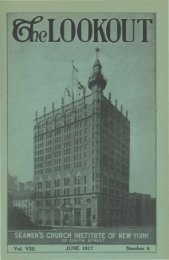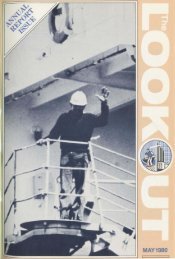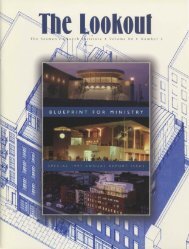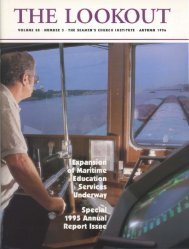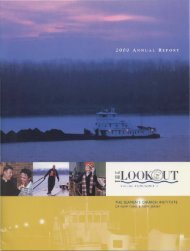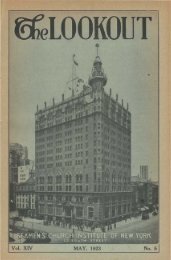Lookout 1970 Oct.pdf
Lookout 1970 Oct.pdf
Lookout 1970 Oct.pdf
Create successful ePaper yourself
Turn your PDF publications into a flip-book with our unique Google optimized e-Paper software.
Potpourri<br />
The 34th annual conference of the<br />
International Council of Seamen's<br />
Agencies will be held in the Institute<br />
building <strong>Oct</strong>ober 19-21. The Council is<br />
composed of organizations in the<br />
Western Hemisphere.<br />
Its representatives meet each year<br />
to discuss goals and problems common<br />
to Council members and how to promote<br />
the best interests of seamen. The<br />
SCI is a Council member.<br />
The Rev. Dr. John M. Mulligan and<br />
Peter Van Wygerden of the Institute<br />
staff have been active in setting up<br />
this year's conference.<br />
* * *<br />
The Rev. Laurent Van Dijck, a Belgian<br />
priest from Antwerp who serves<br />
both as a chaplain and language instructor<br />
aboard a Belgian cadet training<br />
vessel, visited the SCI for two<br />
weeks in August.<br />
He has been serving on the cadet<br />
ship for three years; prior to this he<br />
was a priest in a home for the handicapped<br />
in Sicily.<br />
LOOKOUT<br />
Vol. 61 No.8 <strong>Oct</strong>ober <strong>1970</strong><br />
Copyright <strong>1970</strong><br />
SEAMEN'S CHURCH<br />
INSTITUTE OF NEW YORK<br />
15 State Street, New York, N.Y. 10004<br />
Telephone: 269-2710<br />
The Right Reverend<br />
Horace W. B. Donegan, D.D., D.C.L.<br />
Honorary Pre8ident<br />
John G. Winslow<br />
Pre8iden t<br />
Father Van Dijck believes the Belgian<br />
system of training men to become<br />
officers in the merchant marine is t he<br />
best in the world.<br />
"The young men get practical onboard<br />
ship training under the close supervision<br />
of experienced instructors<br />
whHe the ship is performIng as a conventional<br />
cargo ship during conventional<br />
voyages throughout the world,"<br />
he pointed out.<br />
The three-year cadet training course<br />
is government-subsidized and the<br />
trainees occupy quarters on a special<br />
deck on the ship apart from the regular<br />
crew. The cleric teaches French and<br />
English with the aid of voice tapes and<br />
other modern language instructional<br />
devices.<br />
* * *<br />
Thomas McCance, a New Yorker,<br />
wrote The <strong>Lookout</strong> to comment on a<br />
coincidence. Mr. McCance said in his<br />
note: "I was interested to read in the<br />
July-August issue the account of the<br />
tragedy of the H ornet by J. R. Crane.<br />
This was of particular interest because<br />
Henry Ferguson, one of the two<br />
passengers on the Hornet referred to<br />
in the article, was my wife's grandfather.<br />
We have a copy of his diary as<br />
well as a copy of Captain Mitchell's<br />
diary."<br />
The Rev. John M. Mulligan, D.D.<br />
Director<br />
Harold G. Petersen<br />
Editor<br />
Published monthly with exception of July·August and<br />
February-March when bi·monthly. Contributions to the<br />
Seamen's Church Institute of New York of $5.00 or more<br />
include a year's subscription to The lookout. Single subscriptions<br />
are $2.00 annually. Single copies 50¢. Addi·<br />
tional postage for Canada, latin America, Spain, $1.00,<br />
other foreign, $3.00. Second class postage paid at New<br />
York, N. Y.<br />
COVER: "Mooncussers" prepare to board wrecked ship<br />
grounded on a rocky beach - to strip the vessel of cargo,<br />
valuables and equipment.<br />
by Abbie M. Murphy<br />
"Mooncussers," as the term was<br />
used in the 18th Century, designated a<br />
special group of villains and no others.<br />
It was a term coined for those men who<br />
lured ships on to the shore by means of<br />
false lights. They then murdered the<br />
crew and plundered the wrecked ships.<br />
Naturally, dark and moonless nights<br />
provided the perfect background for<br />
such nefarious doings, and no doubt<br />
the plunderers did cuss a brilliant moon<br />
when they could not work under cover<br />
of the darkness they wished for.<br />
Cape Cod, Massachusetts, extending<br />
like a mighty arm out into the Atlantic,<br />
is a place of legends and stories of<br />
all kinds ... but Cape Codders, at least,<br />
do not especially enjoy the tales of<br />
mooncussers on their shores.<br />
"All that stuff", they maintain, referring<br />
to latter day mooncussers,<br />
"comes out of books!"Not so, many authorities<br />
maintain ... they were there,<br />
certainly. And these authorities go on<br />
to tell that the term "mooncussers" was<br />
passed on to their "brethren" who followed<br />
them: the Cape Cod "wreckers".<br />
As the years passed, and maritime<br />
activity reached a peak in New England,<br />
many ships were wrecked on the<br />
treacherous shoals and bars of the<br />
Cape, with its peculiar and variable<br />
tidal action. Terrible storms roared in<br />
upon it.<br />
Especially dangerous for shipping<br />
was the so-called "back side" of the<br />
Cape. This locale is the exposed "Great<br />
Beach" or Nauset Beach, now a national<br />
park site. It is here that the powerful<br />
Atlantic pounds unmercifully,<br />
shifting the coastline, swirling about<br />
in furious tides and eddies, and, especially<br />
in a "northeaster", forcing the<br />
best of ships and the most skillful of<br />
masters on to the terrible Cape reefs,<br />
where the doomed vessel pounds herself<br />
to pieces.<br />
The laws of ship salvage originated<br />
in Rhodes, about 900 B.C., and were<br />
observed for centuries as a guide to<br />
the disposition of goods taken from<br />
wrecked ships. These early laws were<br />
strict and clear, but they were not always<br />
observed; "From every part of<br />
Europe," we are told, "the plundering<br />
of vessels wrecked on nearby shores<br />
seems to have been carried on without<br />
mercy through the Middle Ages."<br />
3
The Mississippi River from the<br />
mouth of the Yazoo River to Grand<br />
Gulf. Until Vicksburg fell in early<br />
July 1863, this section of the<br />
Mississippi was the scene of<br />
concentrated action.<br />
Indianola runs aground near<br />
Jefferson Davis plantation<br />
below Vicksburg and is<br />
surrendered to rebels.<br />
by James M. Powles<br />
The night of February 25, 1863 was<br />
quiet and cold. The Confederate forces<br />
defending the strong fortress of Vicksburg,<br />
Mississippi, were all asleep except<br />
the rebel pickets who were standing<br />
their lonely posts constantly alert<br />
for any sign of the enemy.<br />
Vicksburg and its vast array of defenses<br />
was pinned in a powerful Union<br />
vise. A large Federal army under General<br />
U. S. Grant was encamped around<br />
the perimeter of the city while up the<br />
Mississippi River lay the Union gunboats<br />
and ironclads of Acting Rear Admiral<br />
David Porter. The Union forces<br />
wanted Vicksburg very badly since it<br />
was the last Confederate stronghold on<br />
the Mississippi and if it fell the Union<br />
would have control over one of the<br />
South's main arteries of supply.<br />
Walking along the shore of the river<br />
above Vicksburg, a Confederate sentry<br />
gazed aimlessly at the swift-flowing<br />
waters of the mighty Mississippi. His<br />
thoughts were interrupted as he caught<br />
sight of a dark shadow moving downstream.<br />
For several seconds he stood<br />
breathless as it came closer and gradually<br />
materialized into the largest,<br />
most powerful ironclad warship he had<br />
ever seen. Catching his breath, the<br />
sentry took off to sound the alarm.<br />
Within a short time Vicksburg was<br />
alive with the sounds of men and horses<br />
being deployed. Artillerymen were<br />
roughly awakened and sent immediately<br />
to their guns to make them ready<br />
for the intruder. On the inland side of<br />
the city the Confederate soldiers facing<br />
Grant's army were put on alert. General<br />
J. C. Pemberton, commander of the<br />
city, was not going to take any chances.<br />
This ironclad could be trying to run<br />
past the city's batteries as did the Union's<br />
Indianola and Queen of the West<br />
a few days before, or it could be the<br />
beginning of a massive Union attack.<br />
As the huge "ironclad" came within<br />
range of the first Confederate battery<br />
she was met by a tremendous bombard-<br />
9
10<br />
"Black Terror" causes Indianola to be blown up by Confederates.<br />
ment. Moving down-river with the current,<br />
the vessel received the same heated<br />
reception from each battery she<br />
passed.<br />
Shot plunged into the water beside<br />
the warship sending geysers of water<br />
over her and others whistled past her<br />
two tall smokestacks.<br />
Not all the shells missed; some<br />
crashed into her huge black casemate<br />
while others ripped the two boats hanging<br />
near the stern into kindling.<br />
Finally the ironclad passed out of<br />
range of the last battery and pressed<br />
on out of sight. The Confederate gunners<br />
along the river could not believe<br />
what they had seen; despite their murderous<br />
fire, the ironclad had casually<br />
steamed through it all seemingly without<br />
serious damage and not bothering<br />
to fire her many guns in reply.<br />
Far upstream Admiral Porter relaxed<br />
as he heard the thunder of Vicksburg's<br />
cannons. He fervently hoped the<br />
rebels poured every ounce of powder<br />
and shot they had into the ironclad.<br />
It was not that the Admiral cared<br />
little of his men or ships but the ironclad<br />
could be literally blown out of the<br />
water and not a single life would be<br />
lost aboard her.<br />
For this "warship" was nothing<br />
more than a magnificent hoax set up<br />
by Porter.<br />
* * *<br />
This hoax began several days before<br />
when the formidable Union ironclad<br />
Indianola was sent down below Vicksburg<br />
to aid the Union gunboat Queen<br />
of the West in her effort to cut the rebel<br />
supply line from the Red River. The<br />
Indianola had successfully passed<br />
Vicksburg and reached the area of the<br />
Red River only to find that the Queen<br />
had been captured.<br />
The Indianola then attempted to go<br />
back up river and report to Porter, but<br />
was attacked by the Confederate river<br />
defense flotilla which included the recently<br />
captured Queen.<br />
Although putting up a good fight ,<br />
the Indianola's stern was stoved in by<br />
the Confederate ram Webb. Sinking<br />
rapidly, the ironclad was run aground<br />
on shore neal' Jefferson Davis' plantation<br />
and surrendered. Shortly thereafter,<br />
the Indianola was set upon by a<br />
rebel salvage crew bent on refloating<br />
her so she could be enlisted into the<br />
Confederate river flotilla.<br />
Word reached Admiral Porter that<br />
night of the loss of his two vessels and<br />
he immediately called a conference of<br />
his staff. The Queen and Indianola in<br />
Confederate hands posed a serious<br />
threat to the Union fleet and the campaign<br />
against Vicksburg. Porter knew<br />
he must keep the Confederates from<br />
refloating the Indianola, but how?<br />
It would be foolish to send another<br />
ironclad down to detroy the Indianola<br />
since a third vessel might well suffer<br />
the same fate as the Indianola and he<br />
was not ready to move in force. After<br />
much discussion with his officers, Porter<br />
hit on a plan.<br />
* * *<br />
The next day a convincing replica<br />
of an ironclad was built alongside an<br />
old wharf. An old coal barge and logs<br />
were assembled into a 300-foot hull.<br />
On to this went a huge "casemate" of<br />
logs painted with black tar. Empty<br />
meat barrels were piled one on top of<br />
another to form two tall "smokestacks"<br />
and at the bottom of each was placed a<br />
pot of oakum and tar which when set<br />
afire would produce thick black smoke.<br />
N ear the stern two "paddlewheel"<br />
boxes were attached, painted with the<br />
words, "Deluded People, Cave In" in<br />
large letters. Just aft of the empty<br />
paddlewheel boxes two old boats were<br />
hung. As a final touch, thick logs were<br />
cut and placed in the casemate to resemble<br />
cannons of the largest caliber.<br />
The dummy ship was constructed<br />
and ready to go by dusk and the Admiral<br />
and his staff gathered at the<br />
wharf to watch the black monster cast<br />
off. Like all ships, she needed a name<br />
and was given one by the onlookers, the<br />
Black Ten'or. As the towboats slowly<br />
maneuvered the fake ironclad away<br />
from the wharf, her two flags could<br />
barely be seen in the fading light.<br />
At the stern flew the Union flag, and<br />
a pendant with a skull and crossbones<br />
waved at the bow. At midstream the<br />
towboats cast off their lines and the<br />
current caught the "ironclad", pushing<br />
her downstream toward Vicksburg.<br />
The next morning, following the<br />
bombardment of her by the Confederate<br />
batteries, she drifted aground below<br />
the city. Fortunately the area was<br />
under control of Union soldiers who<br />
worked to free her - which they did<br />
after several hours. Meanwhile at<br />
Davis plantation word was received<br />
from Vicksburg of the passing of a<br />
"giant ironclad". The crew working on<br />
the Indianola were ordered to destroy<br />
the ship if the Union "warship" approached.<br />
At the same time the captured Queen<br />
of the West reached the town of Warrenton<br />
(just below where the dummy<br />
vessel had run aground) to pick up<br />
pumps and other gear needed to raise<br />
the Indianola. Suddenly the black monster<br />
was sighted from shore.<br />
The Queen hurriedly cast off to warn<br />
the Confederate crew on the captive<br />
Indianola. For a time the Queen of the<br />
West gained no distance on the sham<br />
ironclad but gradually she increased<br />
steam and drew ahead.<br />
The Queen reached Davis plantation<br />
far ahead of the black monster. With<br />
news of the approaching "ironclad",<br />
the rebel crew aboard the Indianola had<br />
no choice but to blow her up. With a<br />
tremendous roar and brilliant flash,<br />
the Indianola was shattered, useless<br />
to either side. The Queen, along with<br />
the Webb, beat a hasty retreat downriver.<br />
The ersatz "ironclad" nevel' reached<br />
the Indianola; she ran aground again<br />
above the Davis plantation and later<br />
was found by Confederate soldiers.<br />
When the southern people learned of<br />
the hoax and its disastrous results,<br />
they were shocked and highly critical<br />
of their forces.<br />
To Admiral Porter goes the distinction<br />
of having transformed a near disaster<br />
into victory with a make-believe<br />
warship. The Black Ten'or was one of<br />
the smartest ruses of the Civil War.<br />
11
12<br />
by Alan Major<br />
The name, Teodor J ozef Konrad Korzeniowski,<br />
may not mean anything to<br />
most persons, but his pen name of<br />
"J oseph Conrad", writer of seafaring<br />
novels, is better known. His life on the<br />
sea and elsewhere was as adventurous<br />
as anything he ever wrote; in fact,<br />
many of his early escapades formed<br />
the basis of some of his bDoks.<br />
The SCI library is named in his honor<br />
and contains several of the writer's<br />
memorabilia, personal letters, portions<br />
of original manuscripts, etc. The serenity<br />
of facial expression on a large<br />
carved wooden bust of Conrad mounted<br />
on the library wall belies the turbulence<br />
of his early life.<br />
Korzeniowski was born in 1857, the<br />
son of a Polish revolutionary. His<br />
youth was spent in Poland and the Ukraine<br />
until at the age of 13 he arrived<br />
in Marseilles and joined the French<br />
merchant navy. 1876, however , saw<br />
Korzeniowski, now 19, involved in more<br />
infamous activities. As a crew member<br />
of a French schooner running cargoes<br />
of guns and ammunition into<br />
Spain, from France, to a remote beach<br />
near Barcelona, in support of the cause<br />
of the Carlist Pretender to the Spanish<br />
throne, Korzeniowski was nearly<br />
killed.<br />
On one trip the schooner was intercepted<br />
by a Spanish warship. The crew<br />
knew it would receive no mercy if the<br />
vessel was boarded and captured, but<br />
would be put to death without trial. As<br />
a last desperate move, the captain deliberately<br />
ran the vessel on to the rocky<br />
coast, allowing the crew to scramble<br />
to safety.<br />
For a few days they lay low until<br />
the hunt for them died down, then Korzeniowski<br />
with his two shipmates made<br />
their way over the border into France<br />
and split up. Korzeniowski decided to<br />
go back to Marseilles.<br />
Here he met the desirable young<br />
Hungarian girl friend of the Spanish<br />
Pretender, Paula de Somogyi. She was<br />
at once madly attracted to the handsome,<br />
adventure-seeking Korzeniowski.<br />
For him she was everything he desired<br />
in a woman. Soon they fell in<br />
love, left Marseilles, and travelled to<br />
a cottage Paula knew in the Alps. Here<br />
they spent several weeks in an idyllic<br />
existence. But Paula also had had many<br />
other male admirers and one morning<br />
one of them arrived at the cottage.<br />
At first there was an uneasy truce<br />
between the two men, but that night,<br />
as the wine flowed, Paula flirted with<br />
both of them and an argument began.<br />
Korzeniowski, trembling with rage,<br />
challenged the other man, "If it's a<br />
fight you need let's duel like gentlemen<br />
not brawl like ruffians." The other man<br />
accepted and chose pistols.<br />
Paula begged Korzeniowski not to go<br />
through with it, but he refused because<br />
his Polish pride told him he would<br />
never be able to live with himself if he<br />
withdrew. Next day at 9 o'clock the<br />
two men met in a lonely field near the<br />
cottage. The rival was confident; he<br />
was an expert shot. The two men took<br />
the traditional twelve paces and turned<br />
to face each other's pistol barrels.<br />
Korzeniowski gallantly aimed at the<br />
other's pistol hand, but his opponent<br />
was no gentleman and aimed at Korzeniowski's<br />
heart to kill. The bullet<br />
missed the heart by only inches, and he<br />
lay near death for several days, nursed<br />
by Paula. After several weeks of care<br />
and nursing the wound healed and Korzeniowski<br />
recovered, but all his savings<br />
had been spent on riotous living before<br />
the shooting and on doctors' bills.<br />
Realizing Korzeniowski had no<br />
money, the faithless Paula fell out of<br />
love with him and returned to her<br />
Spanish Pretender in Marseilles. But<br />
he was probably also tired of Paula, as<br />
Korzeniowski later heard she had left<br />
the prince and married an opera singer.<br />
Despite this, Korzeniowski never forgot<br />
Paula. Years later he wrote a novel,<br />
"The Arrow of Gold,"based on his gunrunning<br />
experiences and brief life with<br />
Paula.<br />
After this event in his life was over,<br />
Korzeniowski went back into the<br />
French merchant service until, in 1878,<br />
he landed at Lowestoft, England. He<br />
learned English, took British nationality<br />
and obtained a job as mate on an<br />
English ship. Later he rose to become a<br />
master mariner in the British merchant<br />
service. In 1884 he left the sea<br />
and began to write novels.<br />
Realizing his long Polish surname<br />
would be unsuitable to use on the cover<br />
of his books, he took the English versions<br />
of his two middle Christian<br />
names as his pen name-Joseph Conrad.<br />
He had a beautiful prose style and<br />
his novels are remarkable for their<br />
vivid descriptions of the seafaring life.<br />
His novels are still in print in Britain<br />
and much read.<br />
Some of them are "Almayer's Folly,"<br />
1895, "An Outcast of the Islands,"<br />
1896, "The Nigger of the Narcissus,"<br />
1897, "Lord Jim," 1900, "Typhoon,"<br />
1903, "Romance," 1903, "The Mirror<br />
of the Sea," 1906, "Under Western<br />
Skies," 1912, "Twixt Land and Sea,"<br />
1912, "Arrow of Gold", 1919.<br />
From 1919 Conrad lived in a large<br />
rambling mansion, "Oswalds," alongside<br />
the village church at Bishopsbourne,<br />
near Canterbury, England, but<br />
still only a few miles from the sea.<br />
After his death in 1924 he was buried<br />
in ·the cemetery at Canterbury, within<br />
sight of the cathedral.<br />
13




